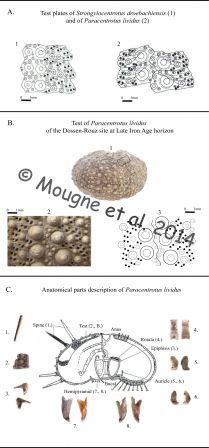Mougne C., Dupont C., Baudry A., Quesnel L., Daire M.-Y., 2014 – Acquisition and management of the marine invertebrates resources on a pre-roman coastal settlement: Dossen-Rouz (Locquémeau-Trédez, Brittany, France).
Par Catherine Dupont le samedi 22 novembre 2014, 16:27 - Zoom sur publications - Lien permanent
Mougne C., Dupont C., Baudry A., Quesnel L., Daire M.-Y., 2014 – Acquisition and management of the marine invertebrates resources on a pre-roman coastal settlement: Dossen-Rouz (Locquémeau-Trédez, Brittany, France). In: Szabó K., Dupont C., Dimitrijevic V., Gastélum Gómez L. G., Serrand N., (eds.), Archaeomalacology: Shells in the Archaeological Record. Proceedings of the 11th ICAZ International Conference. Paris - Archaeomalacology Working group, 23-28 August 2010, France, BAR International Series 2666. Archeopress, Oxford, ISBN 978 1 4073 1308 5. 203-216.

Determination and description of the violet sea urchin (Paracentrotus lividus). A.1 and A.2 : (after Mortensen, 1943; Southward and Campbell, 2006); B.1 : Test of Paracentrotus lividus of the Dossen Rouz site at Late Iron Age horizon (L=48mm); B.2 : Zoom on the test in order to identify the species; B.3 : Shematic drawing of zoom B.2; C.1 : L=11mm; C.2 : L=7mm; C.3 : L: 6mm; C.4 : L=6mm; C.5 : right L=8mm; C.6 : left L=8mm; C.7 : left L= 14mm; C.8 : right L = 14mm (after Jammes 1904) (CAD C. Mougne)
Abstract
The Dossen Rouz settlement, located on the seashore of the commune of Locquémeau-Trédrez, (Brittany, North western France) was dedicated to the production of sea salt during the Late Iron Age (3rd-2nd cent. BC). This archaeological site has revealed the exploitation of a large spectrum of animal species (shells, crustaceans, echinoderms, fishes and mammals). This archaeological deposit has been modified by the modern seaborne incursions of shell. The distinction between natural and anthropic accumulations is essential to understand how the deposit was created. In this paper we attempt to recognize natural deposits in the aim to obtain some reliable data on the Iron Age diet of Dossen Rouz. The variety and the quantity of archaeological marine invertebrate remains encountered are significant for the Iron Age at Dossen Rouz. For shells and especially sea urchins, rarely identified in archaeological contexts, metric quantitative and taphonomic studies, have allowed us to develop new approaches, such as acquisition methods.
Commentaires